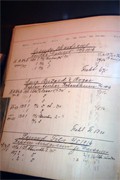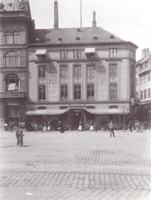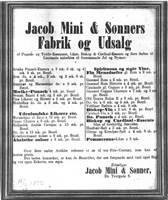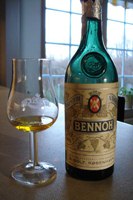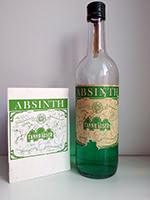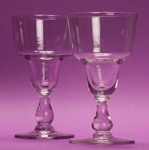Absinthe.se
The premier independent absinthe resource since 2003
Musset didn't write the way he did because he drank absinthe, instead he drank for the same reason for which he wrote just like that: namely out of despair.
Tjänstekvinnans Son
(The Son of a Servant)
Absinthe history in Scandinavia
Several famous Nordic authors, poets and painters are often connected to absinthe in one way or the other. Either they were known to drink it, or they mentioned it in their works. But how widely spread was absinthe really all the way up here in the north? I am uncovering some of that history here - a constant work in progress...
The French connection
To begin the uncovering of absinthe history in Scandinavia we need to understand that life in Sweden, Denmark or Norway wasn't exactly like life in Paris. Absinthe, being known as a drink of artists didn't really have a place here. Small countries way up north where most people didn't exactly have an abundance of money and much rather drank their homemade hard liqour. That is, until the artists brought the demand for it here and the major cities became cultural centers and "Frenchified".
Most of the successful painters and writers of the time at one point or another went to France, Germany or Switzerland to study their arts or to be inspired and write. Upon their return they brought part of that with them. France being an important inspritation for much of Europe led to typical French life being adapted in the larger, slighty more "international" cities, bringing in absinthe to the wine stores and cafés.
Scandinavians in Paris, Berlin and elsewhere
As mentioned most of the painters and writers went to France or Germany to study or work. Being away from home they often sought company with fellow countrymen or other Scandinavians. This is also how they all somehow are connected to each other and other well known artists of the time.
August Strindberg was friends with Edvard Munch who was friends with Christian Krogh who was friends with Fritz Thaulow who was friends with Oscar Wilde who in his later life became friends with Norwegian Jappe Nilssen etc.
Many of them met both in Paris and Berlin during the late 1800's and between 1892 up to 1895 in Berlin "the Scandinavians" frequented a restaurant/inn called Zum Schwarzen Ferkel (The Black Piglet). The name was actually made up by Strindberg and the place was in fact originally named Gustav Türkes Weinhandlung und Probierstube. Strindberg came up with the alternative name because he thought the Armenian wine-sack hanging over the entrance resembled a black piglet. Along with the Scandinavians were some German writers and also pole Stanislav Przybyszewski. Przybyszewski, Strindberg and Munch eventually became enemies because of a woman - Dagny Juel. Other members of the circle were Norwegian painter Christian Krogh (and his wife), Norwegian writer Gunnar Heiberg, Finnish writer Adolph Paul and others.
Several of these friends also met in and around Paris both before and after this. For instance Munch met Strindberg again in Paris during Strindberg's Inferno crisis.
French soldiers spread their absinthe tradition
It is a well known fact that French soldiers located in French colonies brought their love for absinthe with them back to France upon their return. The same thing was of course true for soldiers of any other nationality and even though there wasn't enough Swedish soldiers fighting with the French troops to actually have a large impact on absinthe's popularity in Scandinavia the following goes to show that travelling for whatever reason did affect life back home as customs were brought back.
In the book Breven från Tonkin (Letters from Tonkin), the true story about Swedish legionaire Martin Sandell in French Indochine, a letter written by Martin to his love at home is included. In the letter, dated 19 October 1896, he writes (my translation);
"A couple of days ago, right next to me, two of my closest friends were killed in a battle with the pirates. One of them, very young - only 26 years old, fine looking with a bright future ahead of him and one of my best friends. You can see him in a photo I send you - L'heure de l'absinthe. The other one was only eighteen years old and had joined the troop out of curiosity."
Even in war-struck Indochine the Green hour was intact.

From the book Letters from Tonkin (Breven från Tonkin)
Heure de l'Absinthe. Martin Sandell in the middle
and a bottle of Pernod Fils in front of him.
Absinthe history in Sweden
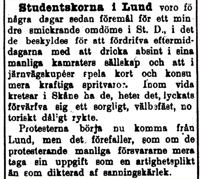
Female students in Lund,
Dalpilen 18 December, 1908
During this time the cultural drink of choice (and for most others as well) was in fact Punsch. Every wine merchant with some kind of dignity made their own brand of Punsch. Absinthe would never grow big enough to threaten Punsch as the king and certainly never as popular as beer or aquavit but in and around the major cities and university towns absinthe was readily available.
When most people think of absinthe and Sweden they immediately think of Strindberg and other artists of his time, the years around 1900. However, absinthe was imported to Sweden long before that, something you can see in Customs and taxes lists for products and product groups being imported to Sweden.
Even though absinthe never had the same impact in Sweden as it did in France, Switzerland and elsewhere it did stir up some controversy and headlines in the newspapers. A small article from the newspaper Dalpilen dated 18 December, 1908 tells how the female students of the university of Lund (in southern Sweden, close to Malmö) "received a less flattering judgement" where they were accused of "spending their afternoons by drinking absinthe in the company of their male friends and playing cards and consuming hard liqour in train compartments." Clearly not good for their reputataion... It goes on to explain that the ladies have consolidated a "notorious bad reputation".
Sweden was in essence a country of drunks during the late 1800's and the Temperance movement grew stronger and stronger. With absinthe not being the most popular drink in Sweden it wasn't targeted in particular as in several other countries but every once in a while they did mention it. In a book titled Rusdryckernas Blodskuld from 1878 the author, and one of the front figures of the Swedish temperance movement at the time, Joseph Hermelin, wrote (my translation);
And who is he, with a gaze teeming with fantasy and inspiration, on whose lovely forehead genius and creative force rests, with the nervous twitches around the bitterly pressed lips? Trembling from cold, he covers his nudity with an old torn uniform coat. His name is Edgar Allan Poe. He has in hereditary from his ancestors in two, three generations recieved nothing except a raging, unquenchable thirst for liqour. He is just now on his way to a publisher, to sell his over the world widely known and admired piece "The Raven". He needs a loaf of bread for himself and a bottle of medicine for his young wife, who's lying dying of phthisis on a straw sheaf in a musty cellar. He's fighting against his pitiful weakness, his lack of resistance with the persistency of dispair, during tears and curses. Nothing shall save him. There sits Alfred de Musset writing with a trembling hand on the label of his absinthe bottle:
"Here goes the safest path ahead - to sin."
Availability of absinthe in Sweden
Looking at old price lists it is clear that the brands that made their way up here were often the higher quality ones. Pernod Fils, C.F Berger, Noilly Prat, Bouvier Frères and more. In some price lists they simply list "Extrait d'Absinthe" and this can mean either a well known brand such as Pernod Fils or the fact that they bought absinthe in bulk and bottled themselves or possibly a lower quality essence mix. However, the price indicates that it is likely a mid- to high end product. Comparing prices on absinthe with other liqueurs and drinks at the time it is obvious that absinthe was priced similar to the high end Bénédictine and Chartreuse etc. Swedish Punsch and other domestic liqueurs and aquavit was half the price or less.
The finer establishments in the larger cities all sold absinthe. Not surprising of course - it was a big drink all over Europe but in Sweden it seems that it was rather limited to the larger cities.
For example Hotel Rydberg in Stockholm and Bern's Restaurant are very well known establishments that served absinthe to both society and upcoming writers and artists. Bern's is the locations for the Red Room where August Strindberg and his friends used to meet for drinks and endless discussions. More than one absinthe have been served in there. Hotel Rydberg is actually mentioned in the book Dr Glas by Swedish author Hjalmar Söderberg. In the book he writes (my translation);
"When I came up to Gustav Adolfs torg I glanced through the windows of Rydbergs pondering maybe Markel would sit there by his absinthe, as he sometimes do, but only Birck was there with a glass of lemon."
Before the Swedish government decided to monopolize wine and spirits distribution and manufacture in Sweden the stores were private companies and as in any other store you could set up a credit. Maybe not the best for national health at the time, but very good for me in my research. One of the finer wine merchants in Stockholm was K.A Nydahl & Co. Vinhandel. The Swedish Wine & Spritis museum (Vin och Sprithistoriska museet) have created a display with interior and books from that store and interesting things can be found in there. In their records of importation you can see that they actually ordered Pernod Fils absinthe as late as in 1918. Three years after the French ban. Shipped out of a bonded warehouse in Marseille, this was perfectly legal though. A full liter of Pernod Absinthe at the time cost SEK 7,00. On display is also their customer credit records and in there we can find a customer of special interest - August Strindberg.
Going further south we come to Helsingborg and a beautifully situated restaurant on a hill, overlooking Öresund with Denmark just across the water located by the tower Kärnan which was originally a medieval fortress, built in the early 1300's. Most of it was destroyed over several hundred years but during 1893-94 the tower part of the castle was restored. Added a few years later was the Terrace. A truly unique setting with beautiful views. This was the location for the restaurant - Terassrestauranten. A wonderful place to enjoy their musical concerts while drinking an absinthe.
Even further south we end up in Malmö. Malmö was mostly an industrial town at the time but being so close to Copenhagen, Denmark and being Swedens third largest city the French influences were notable there as well. In the finer hotels and restaurants such as Kramer Hotel and Hotel Savoy absinthe was of course available.
Absinthe manufacture in Sweden
Malmö was also the location for Swedens finest, and actually one of the finest in Europe, essence manufacturers - Saturnus. Already in 1896 Saturnus made an absinthe essence. As a side note they were also the first to make a Cola softdrink in Sweden, namely Cuba Cola. Released just prior to Coca Cola's release in Sweden - but that was decades later...
Saturnus were known to be extremely meticulous about their products so it's safe to assume that the essence was atleast of high quality and probably made a good effort at producing a drinkable product. What it was like exactly we may never know as neither me nor the people at Saturnus have been able to dig up more information on this. I am not known to give up on these things though.
Considering the closeness to Copenhagen and the fact that a number of absinthes were made there - and taking into account that several of them were nothing but essence mixed absinthes, maybe some of the Danish manufacturers actually did use the Saturnus absinthe essence.
In the city of Karlskrona, also in the south, the wine merchant N.P Nordströms Vinhandel lists a Swedish absinthe in their pricelist from 1880. Since the absinthe isn't listed with a brand name it is possible, though not verified, that it is in fact a product manufactured by the wine merchant himself. Likely an essence mix if that is the case.
Absinthe in Sweden today
Since absinthe was never banned in Sweden it could in theory have been available in Sweden all along. However, demand for it just wasn't that big so it simply faded away when supply from France ended and the monopoly entered Sweden. It was then up to the government to decide what to sell and not. Had the private wine stores continued it's likely that Pernod Absinthe and possibly others would have been imported from Spain instead. Many myths and rumours also state that there was (and some believe there still is) a law prohibiting the imporation of liqour stronger than 60% alcohol by volume. This is not true. There was never any such law. However it was prohibited for private travellers to bring in alcoholic beverages stronger than 60%. This has been revoked since long ago though. Also the government owned Vin & Sprit, the biggest - and up to 1995 the only, importer in Sweden likely had their own policy of not bringing in any liqour stronger than 60%. This was also ended once private import businesses were made legal and Sweden entered the European Union. The above is checked and double checked with both representatives from V&S, historians in Swedish alcohol history, representatives for the Wine and Spirits museum and of course - Swedish alcohol law.
One funny thing though was that during the 1960's a softdrink named Absint was available across Sweden. Several soda and water producers and brewers sold the same product with the same label, which shows it was clearly (another) essence based product, although not actual Absinthe this time... The label depicts a dandy man with a wine-style glass in his hand. The glass with a red drink in it. That red absint soda immediately get me thinking of the German Tabu absinthe alco-pop.
In 1998 when the European Union changed regulations absinthe was once again imported to Sweden. Three years earlier, in 1995, private import companies were made legal and thanks to that new products could enter the Swedish market. Sadly the brand put on the shelves in Swedish liqour stores was Père Kermann. One of the worst "absinthes" on the market. It would take many years before better products would enter the stores. Around 2000 the later discontinued Oxygenée was sold and two years later the disgraceful Pernod Absinthe entered their special order selecetion. In May, 2005, Granqvist's Vinagentur started to import products from the French distillery Combier. Along with their excellent Triple Sec and other liqueurs they also started importing the Jade Nouvelle-Orléans absinthe. The first high quality absinthe to enter the Swedish liqour stores selection. After that, others followed.
Again, in Malmö a company making essences are making absinthe essence. This time it's not Saturnus though but Gert Strand Essenser. A small company producing a multitude of essences for all kinds of spirits. Their various absinthe essences doesn't produce anything even close to a traditional high end absinthe though. Also in Malmö is a liqour manufacturer named Darom. They create various aquavits and also since a couple of years back the first Swedish made absinthe (in modern times) - the Strindberg Absinthe 55. The Prestige August Strindberg Absinthe 55 was released to the public in Sweden in April, 2012. The fact that Darom registered the Strindberg brand for an absinthe caused much noise in media with the Strindberg society and relatives fighting against it. Darom won, and the absinthe was produced. Initially they intended to name it August Strindberg Absinthe 35 with the number 35 referring to the level of thujone content - something I'd say is a good indicator on what to expect from it - another essence mix which need the bad marketing of thujone to sell. Thankfully they opted to use the number 55 instead, which is the same as the alcohol level.
On the better note, in August 2011 a microdistillery named Sankta Annas Bränneri opened up in Lindesberg. They are producing a traditionally distilled absinthe named Absinthe Valkyria. They also distill a wonderful annual Christmas snaps based on the holy trinity of absinthe.
The future for absinthe in Sweden is bright and the journey has barely begun.
Absinthe history in Denmark
Just as Sweden, Denmark was of course influenced by France in many ways but Denmark, and Copenhagen in particular, had another advantage - the large amount of Swiss immigrants. Without much of exaggeration it's pretty safe to say that Copenhagen owes most of its café culture and history to these Swiss immigrants and five families in particular. Needless to say they also helped absinthe's life in Copenhagen and Denmark.
The Swiss conquer Copenhagen
Already back in the 1700's there were immigrants or guest workers coming from Switzerland to Copenhagen but we jump some 100 years ahead and land around 1850. Four families in particular is of interest to us in the search of absinthe history in Denmark, namely well known chocolate manufacturer and café- and bakery keepers; Cloëtta, Mini, Gianelli and Schucani. One thing they all have in common, apart from being Swiss originally, is that they all at one time or another worked together. They either started businesses together or helped in training and financing new businesses.
Some of the most well known places in Copenhagen around the time between 1880 to 1910 include cafés and restaurants run be these families. These include, among others, Café Bernina which for a number of years was run by Schucani. Thanks to the nearby Students association Café Bernina became the foremost place for journalists, authors and painters. In their innermost room the radicals of Copenhagens litterary elite frequently met. Some of the returning customers include big names such as Georg Brandes, Gustav Wied, Agnes Henningsen and Peter Nansen. In fact, in 1887 even the good August Strindberg paid a visit to Café Bernina. In 1906 Bernina was taken over by Gaudenz Gianelli (the younger). Eventually Bernina closed in 1953. For a while a wine store was located in the same place, which kept the name Bernina. Sadly, this is also gone today.
Another fine establishment of the time was Stephan à Porta. à Porta was located on prime location right at Kongens Nytorv. The foundation for it goes all the way back to mid 1790's but the interesting bits for us start in 1819. This is when liqueur manufacturer Jacob Mini (born 1787 in Poschiavo) helped Johann à Porta and eventually took over and ran the café. Inspired by the nearby Hotel d'Angleterre he put more focus on the sale of liqueurs and punsch. Jacob Mini was taught by the Gianellis who ran a café next door. Around 1850 Stephan à Porta took over and this is also when the name for the restaurant was changed to Stephan à Porta.
The photo below show Stephan à Porta at Kongens Nytorv 17 in 1898. The pencil drawings were published in the Danish journal Illustrerede Tidene in 1902 by Danish painters Hans Tegner and Rasmus Christiansen. On the first one we see Gaudenz Gianelli talking to Danish actor Olaf Poulsen, sitting by a table with the characteristic Danish Holmegaard absinthe glass and carafe. The other shows the interior of à Porta.
In 1844 Johann à Porta left the business due to his health and by the hands of Jacob Mini the place was blooming. Known to have waitors with knowledge and a level of service rare in any other establishments in town the reputation grew steady. In 1847, Jacob Mini passed away and his son Geremia Mini took over. After he left the business it was instead run by Gaudenz Gianelli and Stephan à Porta who had also been a partners in the business.
In 1878, Swedish author Claës Lundin wrote what is commonly referred to as the first Swedish science fiction novel, "Oxygen & Aromasia - Bilder från år 2378" (Oxygen and Aromasia - Pictures from the year 2378). A futuristic story - which is a very good read by the way - in which à Porta is mentioned several times and absinthe is referred to.
The passage, starting on the third row, reads;
"But to which building did these vaults belong?"
"Probably the cultivation-establishment called à Porta which had many departments in ancient Copenhagen, but with its main residence close by the national theatre."
"Yes, it's supposed to have been an excellent institution for the education of the higher intelligence. It was an academy of a higher rank which had gatherings every night and also held daily meetings, where everything new in litterature and art of that time underwent the most conscientious review, was approved or rejected, awarded a prize or sentenced to death. There you also, without any difficulty of your own, got to know everything that had happened during the last 24 hours and also what would come the next day."
"There is no such establishment in Copenhagen any longer."
"Everything is changed. With the à Porta institution the use of a glass of absinthe to seek the solution on today's questions and the night's doubts disappeared."
"Absinthe! What was that?"
"It was the water of life for the intellectuals of Copenhagen, just like the aquavit or punsch was the working forces within Stockholm's."
"What strange times!"
(Translated by Markus Hartsmar, Absinthe.se)
In summer 2011 the Café à Porta, still located at Kongens Nytorv 17, went bankrupt.
Of course many other cafés and establishments in Denmark served absinthe during these years but the two above are clearly the two most important ones.
Absinthe manufacture in Denmark
The Mini family wasn't just running some of the most successful cafés in town, they also had a liqueur and essence manufacturing business in Copenhagen. In 1843 the company Cloëtta, Mini & Cie was founded. Located on Dronningens Tværgade 8 the company manufactured punsch, various essences and liqueurs like Maraschino, Curacao and Kirchenwasser Suisse. They also imported Rum and Cognac. However, most important for us is the fact that they manufactured their own absinthe.
Also in the early 1900's there was atleast a couple of other Danish absinthe brands, possibly there were several, namely the L. Perret & Co. in Copenhagen. Very little is yet known about this brand and some claim this was never an actual company or own brand but rather a "fake" french sounding name carried by wine merchant Vilh. Christensen. However, looking at the absinthe bottle branded Perret & Co, it is actually stated the company name "L. Perret & Co. A/S" in the bottom label.
The above photos of the L. Perret bottle used with permission courtesy of Poul Lyng, Danish glass bottle collector.
In 1916 Arthur Fich founded his wine and spirits business Fichs Vinhandel. At this time he also carried an absinthe with his own name as the brand, Arthur Fichs Absinth. Manufactured from essences - yes, I have tried it and it wasn't any good - it is more than likely that he made it himself in the wine store.
Probably the most well known Danish absinthe brand from before the 1980's is Bennoh Absinth. Also starting out as a wine merchant, in 1923 Benni Golf opened up a wine store at Ny Kongensgade 21. The store would be on this same location all the way up to 1970 when the company re-registered as Golf Wine and Spirits Co. A/S and moved to Meterbuen in Skovlunde. The company was there til 1974.
About years after the start, in 1934, Benni Golf manufactured absinthe which he bottled in bottles made by Kastrup Glasværker. The manufacture and sale of the Bennoh Absinth would continue throughout the history of the company. In the 1970's it changed name to Golf Absinth as the company changed name. The Golf Absinth is mentioned in Den Lille Spiritusbog (The Little Book of Spirits) published by Georg Bestle A/S in 1973.
In a way the history of the very successful wine and spirits company Georg Bestle A/S has a funny twist in the end - to us. Georg Bestle was born in 1855 in Copenhagen. His father owned a large wine import business in which Georg worked and learned everything he needed to know about the business. In 1886 he took over another wine import company Gottlieb Bonnesens Vinforretning and when his father died in 1892, he changed the name of this company to Georg Bestle A/S.
The company was to become one of the biggest and most successful and well reknowned liqour businesses in the country. In 1918 he sold the company and retired. The company kept growing and lived on for long. In 1973 they published the book mentioned above, Den Lille Spiritusbog, which mentions Golf Absinth. It also includes a short history and facts lesson about absinthe which is surprisingly correct. In 1974 the company is purchased by Vingaarden A/S, another major wine and spirits company which later, in 2003, is merged with De Danske Spritfabrikker A/S. This results in V&S Danmark A/S which is a subsidiary of the large Swedish wine and spirits company V&S Vin & Sprit AB. Five years later, in 2008, Pernod-Ricard Denmark A/S is founded which is the result of Pernod Ricard buying V&S Group.
In the end, it all falls back to Pernod.
I especially would like to thank Poul Lyng, reknowned Danish glass bottle collector and Jan E. Janssen, author of the excellent book Schweiziske Spor i København, for their help and generosity. Without it I wouldn't have come this far in my research.
Tannhauser and Kruts Karport
In the 1960's there was was a small bar named Tannhäuser originally situated on Tordensskjoldsgade in Copenhagen. For long this was known be the only place you could get absinthe... They sold their own absinthe in the bar but rumour also has it that it was actually absinthe made in Portugal in bulk and then bottled and labelled with their own labels. Wether or not this is actually true, I have yet to find out. Tannhäuser was eventually located on Holbergsgade and, apart from their own absinthe, they carried an enormous selection of whisky.
When Tannhäuser eventually closed another place took over the absinthe torch (no, not literally torching it). In 1984 Kruts Karport opened and ever since then you've been able to get yourself a glass of their own Kruts Karport absinthe in their bar. It is infact made in Denmark by Danish company Taster Wine in Brøndby and yes - it is infact a mix of essences and colorants. Kruts Karport still serves their own Kruts Karport absinthe today and you can buy a bottle of it there, but it's highly overpriced considering what it is you actually get.
Absinthe glasses
Now, jumping back to the 1890's again. Absinthe was actually a popular enough drink for the major Danish glass producers to create absinthe glasses. In France most well known glassware makers had some form of absinthe glass in their catalog but for glass makers up here to bother making them the market must have been rather great. It started with Fyens glass producers making absinthe glasses in 1890. Ten years later, in 1900, production of those same glasses moved to well known Holmegaard Glasværk. Around 1910 Holmegaard purchased Kastrup Glasværk and production was carried out by Kastrup. After Kastrup was closed and completely merged into Holmegaard, production was once again made by Holmegaard. Further more it wasn't only the glasses they made but already since 1890 they also produced glass brouilleurs to go with the glasses. The brouilleur appear for the last time in their product catalog from 1923.
Holmegaard produced no less than three different types of absinthe glasses. Apart from the most common one, the à Porta glass, they also manufactured a Pontarlier style glass and for a short period of time a very stylish more refined variation of the à Porta glass.
The fact is that absinthe was obviously quite popular for a long time in Denmark, being that it was never banned, since Holmegaard continued the production of the à Porta absinthe glasses all the way up to 1950. This is further confirmed by the fact that there was actually absinthe produced in Denmark all the way up to the mid 1970's, with a short break only to come back again in the 80's. During the later years the shape, or rather the size of the dose, of the glasses was altered and the dose was made bigger. Quite visible in the photos below. Today, Holmegaard is part of Rosendahl Design Group.
Story from an author
In the search for information about absinthe in Denmark, and in this case on the Bennoh Absinth in particular, I stumbled across a short novel named Pignon written by Danish author Kenneth Tindall. Of course there have been several books by Danish authors mentioning absinthe before - especially during the late 1880's-1920's, like Gustav Wied's Spader Es (Ace of Spades) for instance. In a passage in that book Gustav Wied lets his characters meet in a bar and order absinthe au lait - absinthe with milk.
However, Pignon was a little more interesting as it specifically named the absinthe Bennoh and was written in modern times. Some of the absinthe related passages from the book reads;
"Would you like some? It’s absinthe. In the oolong... There’s a
building in New York, in Greenwich Village. Bleecker Street. The old
Greenwich Hotel. The high, skylighted atrium. Was that one of
Stanford White’s buildings? In nineteen twenty-nine pigs in starched
shirtfronts were throwing themselves off the galleries down into the
potted palms and the fountain. Do you like absinthe?"
"Ah, absinthe. A royal drink. The dream-within-the-dream..."
"Kirk, did you ever kill a pimp?"
And a passage referencing directly to Bennoh;
"What do you come here for? The music?"
"I’m hanging some on," Arkwright smiled inscrutably.
He reached in and pulled something out of his overcoat. A pocket flask. He opened it, filled the jigger cap and emptied it into his glass. The club soda turned a milky green like the water of Norwegian mountain streams.
"What is that? Pernod?"
"It's Bennoh."
"It's what?"
"Bennoh. It's absinthe."
"Absinthe... I thought that stuff was prohibited years ago."
"This is nineteen years old. A hundred and fifty proof. Cheers!"
They drank. The yunks drank too, leering.
"You surprise me, Arkwright. Who would suspect a fellow like you...
Nineteen-year-old... And where did you get the flask? Do you mind if I
have a look?"
"Of course not. Want a taste? Straight or in your chaser…"
"I'd better not. Where did you get this?"
Arkwright watched him finger the sterling silver covetously, screw
the cap off and sniff.
"At a junk shop in Elsinore."
"Elsinore. I suppose that's where you meet your ghosts."
Finding this, written in 1986 by an author who had also published books in the 60's peaked my interest, so I contacted the author who told me more about Bennoh and the author's and artist's life in 1960's Copenhagen. He told me that they used to drink Bennoh Absinth at a café named Pilegaarden, and how him and his wife were friends with Danish painter Ole Bach whos art dealer used to keep a Demijohn of Bennoh absinthe in the back room of the gallery. Surely exhibitions must have been so much fun.
The above passages from Pignon are quoted with permission from the author. Further use of the material is prohibited according to international law unless permission is granted by the works owner. More wonderful and worthwhile works from Kenneth Tindall can be found here, at Abraword.dk
Absinthe in Denmark today
Since around 2000 absinthe has been readily available in most better wine and liqour stores in Denmark. If nothing else, they often carry the Pernod absinthe. In the very beginning of the revival most stores only carried some of the worst brands possible though, such as Hapsburg, Neto Costa, Trenet etc. Among the slightly better ones at the time were the Spanish essence mixed absentas from Montana and Lasala. If you were lucky you could find an extremely expensive bottle of Segarra Absenta. Distilled and not bad, but very very pricey. It took several years before this would change and more traditional high quality distilled absinthes would enter the danish market.
The Danish Absinthe Association (Absinthium - Det Danske Absintselskab) have made a huge difference for absinthe in Denmark and much thanks to them it is now possible to get high end absinthes from both France and Switzerland in many of the better wine stores. The first distilled, traditionally made, absinthe to enter the Danish market again was Mansinthe which started selling in 2009.
If you want to sample some of the world's best absinthes without buying full bottles of them all, I'd recommend a visit to Copenhagen bar Bliss which is by far the best place in town to get absinthe - served traditionally and with knowledgeable people behind the bar.
Today there is actually more high quality brands available in Denmark than the vile essence and colorant mixes. A good development to say the least. Another step towards absinthe's growing popularity in Denmark was marked when Danish entrepreneur Sven Olsen had the French distillery Les Fils d'Emile Pernot manufacture an absinthe blanche called La Maison Fontaine. The absinthe has become a great success and have won several awards in competitions across the world. No wonder, since it's really really good.
To further fuel the absinthe revival in Denmark, in October 2011 I was reached by the very interesting news that a small microdistillery, Esrum Sø Mikrodestilleri have started making a small batch absinthe. I'm looking forward to trying it...
Written by Markus Hartsmar
- absinthe books and poetry -
Many writers "of old" wrote poems or passages about absinthe. Some drank it, some didn't. Find some of them here as well as reviews and notes on modern books about absinthe.
- latest news and additions -
The Absinthe Poetry section has seen several updates the past days. Poems and information about more authors; Antonin Artaud, Arthur Symons, Francis Saltus Saltus, Florence Folsom and Robert Loveman. Open your mind and have a drink while you enjoy their lyrics.
Read more...
- absinthe.se on facebook -
It's the new bistro, the new bar in town. A good place to meet when meeting in real life isn't always an option. Meet me on facebook for more updates from the absinthe world.







